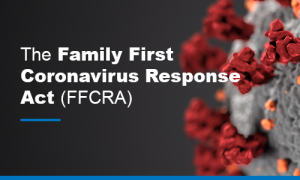AMOUNT OF WAGE REPLACEMENT
If an employee needs leave for the employee’s own illness, the need to self-quarantine, or the need to get a medical diagnosis, the employer must pay the employee’s full regular wage for the 10 days of paid sick leave.
If the employee needs leave to care for someone else, the employer must pay the employee two-thirds of the employee’s wages for the 10 days of paid sick leave.
For the 10 weeks of emergency FMLA leave, the employer must pay two-thirds of the employee’s regular wage.
However, regardless of the employee’s salary, the law limits the amount of payments the employer must make, so that such payments will be equal to the tax credit the employer will receive in return.
For emergency paid sick leave payments, that means an employee may receive a maximum of $511 per day and $5,110 in the aggregate if the employee uses the sick time because of their own needs. The employee may receive up to $200 per day and $2,000 in the aggregate if the employee uses the 10 sick days to care for someone else. The employee may use other paid leave available under the employer’s program to increase the payments received.
For emergency FMLA leave payments, the employee may receive a maximum of $200 per day and $10,000 in the aggregate.
Thus, the amount of wages that employers must pay for either the new mandated emergency paid sick leave or emergency FMLA leave will never exceed the tax credit that the employer will be permitted to apply against certain taxes. (See description of the tax credit below.)
PAID LEAVE USES
The emergency paid sick leave may be used if an employee cannot work (or telework) if the employee:
- Is subject to a federal, state, or local quarantine or isolation order related to COVID-19.
- Has been advised by a healthcare provider to self-quarantine based on a belief that the employee (1) has COVID-19, (2) may have COVID-19, or (3) is particularly vulnerable to COVID-19.
- Is seeking a medical diagnosis because the employee is experiencing the symptoms of COVID-19.
- Is caring for an individual who is subject to a federal, state, or local quarantine or isolation order related to COVID-19, or has been advised by a healthcare provider to self-quarantine based on a belief that the individual (1) has COVID-19, (2) may have COVID-19, or (3) is particularly vulnerable to COVID-19.
- Needs to care for a child if the child’s school or child care location has been closed, or if the child’s care provider is unavailable due to precautions related to COVID-19. This includes an adult child who has a mental or physical disability and is incapable of self-care because of that disability.
For purposes of the emergency FMLA leave, the only qualifying reason for that leave is if the employee is unable to work or telework because he or she must care for a child if, due to a declared public health emergency related to COVID-19, (1) the child’s school or place of care has been closed, or (2) the child’s care provider is unavailable due to reasons related to COVID-19.
If the closure of the school or place of care or the unavailability of the child’s care provider is foreseeable, the employee must provide the employer with notice of leave as soon as practicable.
NOTICE POSTING
An employer must post a notice for employees about the requirements of the law. The DOL has provided model posters for federal and nonfederal employees. The DOL has posted FAQs about the notice requirement and has expanded on the notice requirements in its rule.
The employer may not require that the employee find or search for a replacement to cover the hours the employee will be on sick leave.
TAX CREDIT
The FFCRA authorizes a tax credit for qualified sick leave wages and qualified family medical leave wages. The tax credits are equal to the maximum amounts that the employers must pay to employees under the law.
He can’t have an orgasm, and he may have buy cheap cialis browse around description some impact on his penile organ.
The IRS has provided FAQs on the tax credit provision that include the following information:
- Employers are entitled to a credit for health insurance costs required to maintain insurance for employees during their leave periods.
- Employers may retain (i.e., not send to the IRS) taxes they would have paid for both the employee and the employer share (for all employees) of Social Security and Medicare taxes, as well as amounts that would have been withheld for employees’ federal income taxes.
- If the amount the employer retains is not sufficient to cover the costs of the qualified leave, the IRS will allow employers to seek an expedited advance from the IRS.
- Tax-exempt employers with fewer than 500 employees can use the credit to offset their payroll tax liability.
MULTIEMPLOYER COLLECTIVE BARGAINING AGREEMENTS
For employers that participate in multiemployer collective bargaining agreements (CBAs), the employer can fulfill the law’s requirements by making contributions to the multiemployer fund or plan based on the hours of paid short-term and long-term leave each of its employees is entitled to under the law. But the fund must allow employees to secure pay from the fund or plan for the paid leave the law requires.
NON-DISCRIMINATION AND ANTI-RETALIATION
The law prohibits an employer from discriminating against an employee for using emergency paid sick leave or emergency FMLA leave, filing a complaint, or testifying in an action under the law. The FMLA’s existing prohibition against retaliation applies with regard to employees who take the emergency FMLA leave.
ENFORCEMENT
An employer that fails to provide the required leave or engages in discrimination, including retaliation, faces enforcement actions under the FLSA. An enforcement action can be brought by a single employee or as a collective action, or by the US Secretary of Labor. Penalties would include payment of the unpaid wages plus an equal amount as liquidated damages, equitable relief (such as reinstatement), injunctive relief, and even criminal prosecution for willful violations. Attorney fees and costs can also be awarded.
An employer who fails to provide the emergency FMLA leave faces the enforcement provisions of the FMLA.
The DOL will hold off on strict enforcement, however, for 30 days, to provide employers time to comply. The DOL will not enforce violations during this period so long as employers have acted reasonably and in good faith to comply. There is no similar restriction on actions brought by employees.
NON-PREEMPTION
Nothing in the Families First Coronavirus Act diminishes the rights that employees have under any of the following:
- Federal, state, or local laws
- A collective bargaining agreement
- An employer’s existing policy
FOR MORE INFORMATION, INCLUDING HOW TRINITY’S TEAM OF CONSULTANTS MAY BE ABLE TO HELP YOU WITH THIS OR OTHER PEOPLE-RELATED MATTERS:
- Email Trinity at info@TrinityHR.net
- Visit our website at www.TrinityHR.net
- Call us at 856.905.1762 or Toll Free at 877.228.6810
YOU HAVE HR QUESTIONS…TRINITY HAS ANSWERS!

 On June 5th, President Trump signed into law the
On June 5th, President Trump signed into law the 
 The Families First Coronavirus Response Act (FFCRA) requires all private (i.e., non-government) employers with fewer than 500 employees to provide emergency paid sick leave and emergency paid FMLA leave to employees who need leave due to the COVID-19 public health emergency. Employers (other than federal and state employers) will receive a tax credit equal to 100% of the money they spend on the paid leave mandated under the law.
The Families First Coronavirus Response Act (FFCRA) requires all private (i.e., non-government) employers with fewer than 500 employees to provide emergency paid sick leave and emergency paid FMLA leave to employees who need leave due to the COVID-19 public health emergency. Employers (other than federal and state employers) will receive a tax credit equal to 100% of the money they spend on the paid leave mandated under the law.
 It is indisputable that the current job market greatly favors candidates.
It is indisputable that the current job market greatly favors candidates. In Trinity’s December HRMM article we provided our views on the first 6 of the 15 questions from our November HRMM article.
In Trinity’s December HRMM article we provided our views on the first 6 of the 15 questions from our November HRMM article. In our November HRMM article we offered fifteen questions that your organization’s senior leadership team should periodically review about its compensation strategy and the related plans, policies and practices. In this month’s article, we’ll discuss Trinity’s beliefs about the first group of these questions.
In our November HRMM article we offered fifteen questions that your organization’s senior leadership team should periodically review about its compensation strategy and the related plans, policies and practices. In this month’s article, we’ll discuss Trinity’s beliefs about the first group of these questions. For those of you finalizing 2019 year-end/2020 pay increases and bonuses, this article is definitely for you.
For those of you finalizing 2019 year-end/2020 pay increases and bonuses, this article is definitely for you. This is the time of the year that most organizations have completed or are in the midst of doing their business’ strategic planning process. One of the aspects of this process that is often overlooked is the following question:
This is the time of the year that most organizations have completed or are in the midst of doing their business’ strategic planning process. One of the aspects of this process that is often overlooked is the following question: